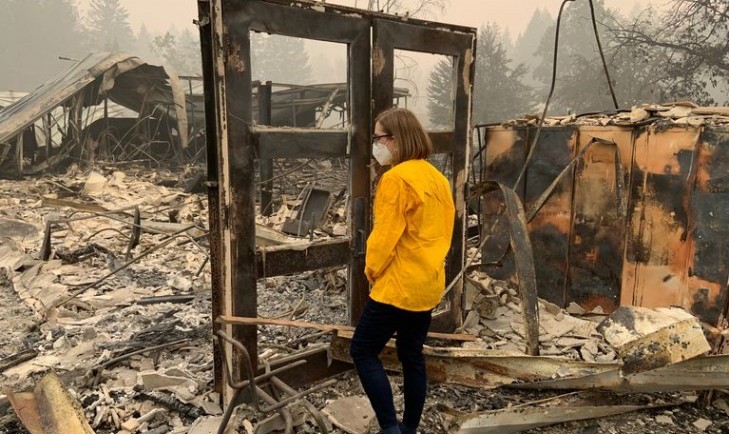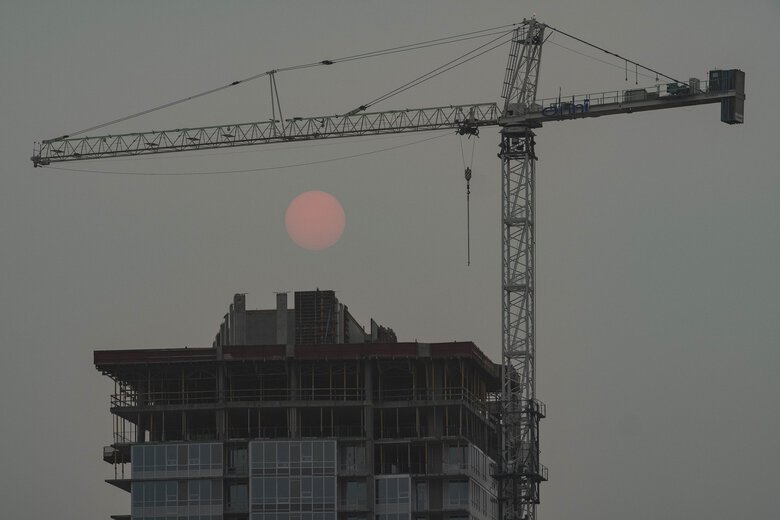
The Western Governors' Association keeps you updated on wildfire news in the West. Here is the latest for the week starting Sept. 14, 2020. Photo: Oregon Gov. Kate Brown visits the site of the Beachie Creek Fire. Courtesy of Oregon Public Broadcasting.
Much of the West remains engulfed in flames, as smoke from dozens of wildfires stretches as far as Mexico, Canada, the East Coast, and even Europe.
In California, 17,000 firefighters are battling 25 major fires, burning 3.4 million acres and resulting in at least 25 fatalities as of Sept. 17, according to California Public Radio. Of those fires, six rank within the top 20 largest in state history, including the August Complex (817,952 acres, 30% contained) – now the largest on record.
On Sept. 15, the Bobcat Fire (50,539 acres, 3% containment) threatened the Mount Wilson Observatory near Los Angeles. Firefighters managed to narrowly save the historic building, despite flames that came as close as 500 feet.
Other major fires in the Golden State include the Creek Fire (228,025 acres, 18% contained), the North Complex (273,335 acres, 36% contained), the LNU Lightning Complex (363,220 acres, 98% contained), the SCU Lightning Complex (396,624 acres, 98% contained), and the CZU Lightning Complex (86,509 acres, 95% contained).
Almost 1 million acres of Oregon is burning as well, with eight fatalities confirmed as of Sept. 15, The Statesman Journal reports. The Almeda Fire, responsible for four deaths and the destruction of 100 homes, is now fully contained.
The Beachie Creek Fire, the state’s largest active incident, has burned 191,238 acres, destroyed nearly 1,300 structures, and killed at least four. It is currently 20% contained as of Sept. 16. Earlier this week, Gov. Kate Brown visited the site of the inferno, alongside State Fire Marshal Marianna Ruiz-Temple, Oregon Department of Forestry (ODF) Director Peter Doherty, and ODF Fire Chief Doug Grafe.
“The heroic efforts of Oregonians, of first responders from all over the region, saved lives, and I’m incredibly grateful for their efforts,” the Governor said. “We still have a lot of work to do as we move into recovery mode.”
Also threatening the Beaver State: the Lionshead Fire (189,316 acres, 10% contained), Riverside Fire (135,956 acres, 3% contained), Archie Creek Fire (121,475 acres, 20% contained), Indian Creek Fire (48,435 acres, 95% contained), Brattain Fire (40,316 acres, 17% contained), South Obenchain Fire (32,8140 acres, 25% contained), Slater Fire (141,403 acres, 10% contained), Two Four Two Fire (4,475 acres, 21% contained), and the White River Fire (17,442 acres, 80% contained).
In Washington, more than 807,000 acres have been scorched, an area about 15 times the size of Seattle. As of Sept. 15, according to The Seattle Times, more than 400 structures have been destroyed, about half of which were homes.
 Earlier this week, the smoke from these fires, mixed with other blazes around the West, led to the worst air quality ever recorded in the Puget Sound region, according to Dan Jaffe, a physical science professor at University of Washington-Bothell who specializes in wildfire smoke. More specifically, particulate matter counts reached 264 micrograms per cubic meter, eclipsing the previous record of 150 from 2018.
Earlier this week, the smoke from these fires, mixed with other blazes around the West, led to the worst air quality ever recorded in the Puget Sound region, according to Dan Jaffe, a physical science professor at University of Washington-Bothell who specializes in wildfire smoke. More specifically, particulate matter counts reached 264 micrograms per cubic meter, eclipsing the previous record of 150 from 2018.
Among the state’s largest wildfires are the Pearl Hill Fire (223,730 acres, 94% contained), Cold Springs Fire (188,852 acres, 70% contained), and the Whitney Fire (127,430 acres, 95% contained).
Colorado is still seeing fire activity as well, most notably the Cameron Peak Fire, which is only 8% contained and holding steady at 102,596 acres as of Sept. 16, according to Fox 21. Larimer County officials report at least 54 buildings, including 25 homes, have been destroyed so far.
Other notable incidents include the Middle Fork Fire (4,807 acres, 0% contained), the Grizzly Creek Fire (32,431 acres, 91% contained), the Williams Fork Fire (12,280 acres, 16% contained), and the Pine Gulch Fire (139,007 acres, 95% contained).
In Montana, where 1,876 fires have burned more than 260,000 acres, weather conditions have lent firefighters a helping hand of late. Operations at the 8,224-acre Bridger Foothills Fire, now 77% contained, have shifted from attack to recovery, as residents return home to dozens of burned-out structures, The Great Falls Tribune reports.
Also burning in the Treasure State are the State Creek Fire (3,140 acres, 50% contained) and the Drumming Fire (3,686 acres, 0% contained).
Idaho is dealing with a few blazes as well, including two fires burning just over 20,000 acres in the Boise National Forest, as well as a 28,000-acre fire in the Sawtooth National Forest. Meanwhile, in Wyoming, the Lone Star Fire in Yellowstone National Park has grown from 3,348 acres to 3,914 as of Sept. 16, according to Oil City News.
Click here for the latest wildfire updates in your state.
Learn more about WGA’s policy work to prevent and combat wildfire in the West.
ICYMI: COVID-19 in the West: A state-by-state breakdown of the Governors’ work (updated weekly)
Get the latest news about the West and its governors by following the Western Governors' Association on Twitter, Facebook and LinkedIn.
Check out our podcast, Out West, on Podbean, Spotify and Apple Podcasts